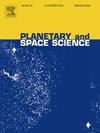火星尘埃光学深度数据集的综合比较,以评估与火星气候探测仪观测的一致性
IF 1.7
4区 物理与天体物理
Q3 ASTRONOMY & ASTROPHYSICS
引用次数: 0
摘要
该研究将火星勘测轨道器上的火星气候探测仪与火星奥德赛号上的THEMIS、火星勘测轨道器上的CRISM、阿联酋号火星任务上的EMIRS、勇气号和机遇号漫游车上的Pancam和凤凰号着陆器上的SSI测量的尘埃光学深度进行了全面的比较。我们在这些尘埃光学深度数据集之间证明了良好的总体一致性,特别是因为这些测量是在不同波长(近红外到热红外)和不同测量几何形状(边缘,从轨道向下看,从表面向上看)下进行的。为了得出我们的结论,我们直接比较了这些仪器在同一地点的测量结果,用纬度和太阳经度平均的尘埃光学深度差图,以及考虑到测量不确定性的修正Bland-Altman分析。从Bland-Altman分析中,我们发现仪器提供的误差估计合理地代表了两个数据集引入的可变性,但没有捕获偏移量。基于我们的研究,我们提出了一些观察到的差异的潜在物理原因,如表面反射因子估计和热对比。通过推导MCS水冰光学深度,我们发现MCS与其他仪器的尘埃光学深度差异呈线性关系。考虑到这种关系,再加上一个常量参数,可以解释数据集之间的一般偏移量,可以显著减少差异。本文章由计算机程序翻译,如有差异,请以英文原文为准。

Comprehensive intercomparison of Martian dust optical depth datasets to assess agreement with Mars Climate Sounder observations
This study provides comprehensive intercomparisons of dust optical depths derived from Mars Climate Sounder on Mars Reconnaissance Orbiter with measurements from the orbiter instruments THEMIS on Mars Odyssey, CRISM on Mars Reconnaissance Orbiter, EMIRS on the Emirates Mars Mission, and from the surface-based instruments Pancam on the Spirit and Opportunity rovers and SSI on the Phoenix lander. We demonstrate good overall agreement between these dust optical depth datasets, in particular as these measurements were taken at different wavelengths (near IR to thermal IR) and with different measurement geometries (limb, downlooking from orbit, uplooking from the surface). To draw our conclusions, we use direct comparisons of co-located measurements from these instruments, plots of the dust optical depth differences averaged by latitude and Solar longitude, as well as modified Bland–Altman analysis that takes the measurement uncertainties into account. From the Bland–Altman analysis, we find that error estimates provided by the instruments reasonably represent the variability introduced by the two datasets but do not capture offsets. Based on our investigations, we propose potential physical causes, such as surface reflectance factor estimation and thermal contrast, for some of the observed differences. We find a linear relation of the differences in dust optical depth between MCS and the other instruments with derived MCS water ice optical depth. Taking this relation into account, together with a constant parameter that accounts for general offsets between the datasets, significantly reduces differences.
求助全文
通过发布文献求助,成功后即可免费获取论文全文。
去求助
来源期刊

Planetary and Space Science
地学天文-天文与天体物理
CiteScore
5.40
自引率
4.20%
发文量
126
审稿时长
15 weeks
期刊介绍:
Planetary and Space Science publishes original articles as well as short communications (letters). Ground-based and space-borne instrumentation and laboratory simulation of solar system processes are included. The following fields of planetary and solar system research are covered:
• Celestial mechanics, including dynamical evolution of the solar system, gravitational captures and resonances, relativistic effects, tracking and dynamics
• Cosmochemistry and origin, including all aspects of the formation and initial physical and chemical evolution of the solar system
• Terrestrial planets and satellites, including the physics of the interiors, geology and morphology of the surfaces, tectonics, mineralogy and dating
• Outer planets and satellites, including formation and evolution, remote sensing at all wavelengths and in situ measurements
• Planetary atmospheres, including formation and evolution, circulation and meteorology, boundary layers, remote sensing and laboratory simulation
• Planetary magnetospheres and ionospheres, including origin of magnetic fields, magnetospheric plasma and radiation belts, and their interaction with the sun, the solar wind and satellites
• Small bodies, dust and rings, including asteroids, comets and zodiacal light and their interaction with the solar radiation and the solar wind
• Exobiology, including origin of life, detection of planetary ecosystems and pre-biological phenomena in the solar system and laboratory simulations
• Extrasolar systems, including the detection and/or the detectability of exoplanets and planetary systems, their formation and evolution, the physical and chemical properties of the exoplanets
• History of planetary and space research
 求助内容:
求助内容: 应助结果提醒方式:
应助结果提醒方式:


